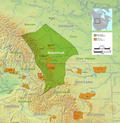Blackfoot language
| Blackfoot | |
|---|---|
| Siksiká (ᓱᖽᐧᖿ) | |
| Native to | United States, Canada |
| Region | Blackfeet Indian Reservation in Montana and Piikani, Siksika, and Kainai Reserves in southern Alberta |
Native speakers | 5,100[1] / 5,000 to <8,000[2] |
Algic
| |
| Language codes | |
| ISO 639-2 | bla |
| ISO 639-3 | bla |
| ELP | Niitsipowahsin |
Template:Contains Canadian text
Blackfoot also known as Siksika (so called in ISO 639-3), Pikanii, and Blackfeet, is the name of any of the Algonquian languages spoken by the Blackfoot tribe of Native Americans, who currently live in the northwestern plains of North America. Like the other Plains Algonquian languages, Blackfoot is often said to have diverged a great deal from Proto-Algonquian. It is significantly different both phonologically and, especially, lexically from the other languages within the family.[3]
Like the other Algonquian languages, Blackfoot is typologically polysynthetic. Benjamin Whorf hypothesized that Blackfoot is oligosynthetic, but later linguists have rejected this theory.
Sounds
Consonants
Blackfoot has ten consonants, of which all but /ʔ/ and /x/ can be phonemically long:[4][5]
| Labial | Alveolar | Velar | Glottal | ||||
|---|---|---|---|---|---|---|---|
| Stop | p | pː | t | tː | k | kː | ʔ |
| Fricative | s | sː | x | ||||
| Nasal | m | mː | n | nː | |||
| Semivowel | w | j | |||||
Blackfoot also has two affricates, /t͡s/, /t͡sː/. The velar consonants become palatals [ç] and [c] when preceded by front vowels.
Vowels
Blackfoot has a vowel system with three monophthongs, /i o a/. Length is distinctive (áakokaawa, "s/he will rope" vs. áakookaawa, "s/he will sponsor a sundance"):[6][4][5]
| Front | Central | Back | ||||
|---|---|---|---|---|---|---|
| Close | i | iː | ||||
| Close-Mid | o | oː | ||||
| Open | a | aː | ||||
There are three additional vowels, called "diphthongs" in Frantz (1997). The first is pronounced [ɛ] before a long consonant, [ei] (or [ai], in the dialect of the Blackfoot Reserve) before /i/ or /ʔ/, and [æ] elsewhere (in the Blood Reserve dialect; [ei] in the Blackfoot Reserve dialect).[7] The second is pronounced [au] before /ʔ/ and [ɔ] elsewhere. The third is /oi/.[8] The short monophthongs exhibit allophonic changes as well. /a/ and /o/ are raised to [ʌ] and [ʊ] respectively when followed by a long consonant, /i/ becomes [ɪ] in closed syllables.[6]
Blackfoot has a pitch accent system, meaning that every word has at least one high-pitched vowel, and high pitch is contrastive with non-high pitch (e.g., ápssiwa, "it's an arrow" vs. apssíwa, "it's a fig").[9] At the end of a word, non-high pitched vowels are devoiced.[5][10]
Writing System
A syllabics script, ᑯᖾᖹ ᖿᐟᖻ ᓱᖽᐧᖿ pikoni kayna siksika, was created by John William Tims ca 1888. Although conceptually nearly identical to Western Cree syllabics, the letter forms are innovative. Two series (s, y) were taken from Cree but given different vowel values; three more (p, t, m) were changed in consonant values as well, according to the Latin letter they resembled, and the others (k, n, w) were created from asymmetrical parts of Latin and Greek letters, or in the case of the zero consonant, possibly from the musical notation for quarter note.
| Blackfoot | Latin source |
|---|---|
| ᑭ pe | P |
| ᒥ te | T |
| ᖼ ke | K |
| ᒋ me | m |
| ᖸ ne | N |
| ᖴ we | digamma Ϝ |
The direction for each vowel is different than in Cree, reflecting Latin alphabetic order. The e orientation is used for the diphthong /ai/. Symbols for consonants are taken from the consonant symbol minus the stem, except for diphthongs (Ca plus ᐠ for /Cau/, and Ca plus ᐟ for /Coi/, though there are also cases of writing subphonemic [ai, ei, eu] with these finals).
| C | -a | -e | -i | -o | final |
|---|---|---|---|---|---|
| (none) | ᖳ | ᖰ | ᖱ | ᖲ | |
| p- | ᑫ | ᑭ | ᑯ | ᑲ | ᐤ |
| t- | ᒣ | ᒥ | ᒧ | ᒪ | ᐨ |
| k- | ᖿ | ᖼ | ᖽ | ᖾ | ᘁ |
| m- | ᒉ | ᒋ | ᒍ | ᒐ | ᐢ |
| n- | ᖻ | ᖸ | ᖹ | ᖺ | ᐡ |
| s- | ᓭ | ᓯ | ᓱ | ᓴ | ᔈ |
| y- | ᔦ | ᔨ | ᔪ | ᔭ | ᐟ |
| w- | ᖷ | ᖴ | ᖵ | ᖶ | ᐠ |
There are additional finals: allophones ᑊ [h] and ᐦ [x], and three medials: ᖿᐧ /ksa/, ᒣᐧ /tsa/, ᖿᑉ /kya/, ᖿ= /kwa/.
᙮ is used for a period.
Notes
- ^ Ethnologue's estimate
- ^ Martin Heavyhead and Don Frantz' estimate
- ^ Mithun (1999:335)
- ^ a b Blackfoot Pronunciation and Spelling Guide. Native-Languages.org. Retrieved 2007-04-10
- ^ a b c Frantz, Don. The Sounds of Blackfoot. Retrieved 2007-04-11
- ^ a b Frantz (1997:1-2)
- ^ Frantz (1997:2)
- ^ Frantz (1997:2-3)
- ^ Frantz (1997:3)
- ^ Frantz (1997:5)
External links
- Ethnologue report for Blackfoot
- Blackfoot language
- Don Frantz's page on the Blackfoot language
- Blackfoot - English Dictionary: from Webster's Online Dictionary, the Rosetta Edition.
References
- Frantz, Donald G. (1997) [1991]. Blackfoot Grammar. Toronto: University of Toronto Press. ISBN 0-8020-7978-4.
- Mithun, Marianne (1999). The Languages of Native North America. Cambridge: Cambridge University Press. ISBN 0-521-29875-X.
